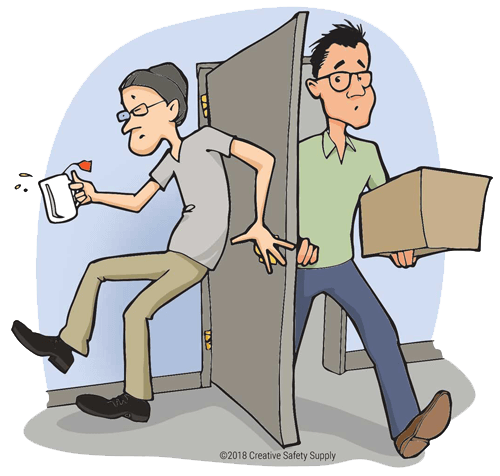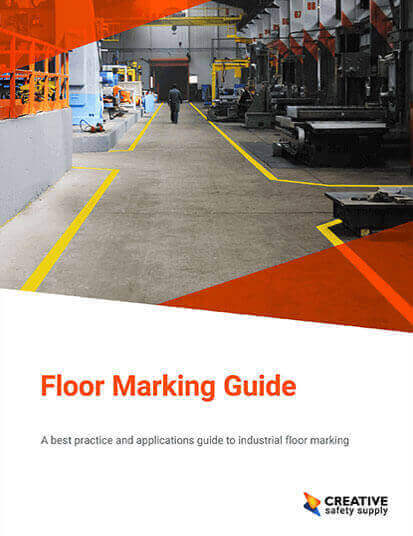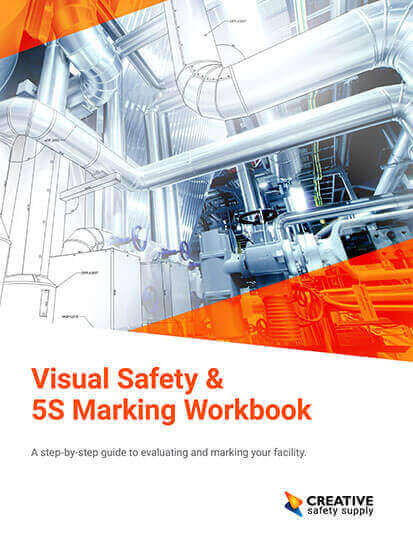
There is one workplace hazard often overlooked in many workplaces— who would have thought opening a door could be so dangerous!
Push open a door yourself and observe how it swings along a set path. Anyone standing in that pathway will get hit, which can cause terrible injuries. Unfortunately, there is no way to see anyone coming either, as most facilities have solid doors that do not have windows.
One great way to make sure everyone is aware of doorway hazards is to apply floor markings that draw attention to the swing radius of the door. This type of floor marking acts as a visual reminder to those in the area, warning them against standing in the pathway of doors.
Remember! One step into the swing zone, even for just a moment, could result in an injury.
Why is Visual Communication Important?

Before we explain why visual communication such as floor marking tape is an excellent addition to the workplace, it may be best to define what visual communication tools are and the types of Lean manufacturing products out there for floor marking.
Visual communication in the context of an industrial setting is the use of visual elements to convey necessary safety measures or facility information.
In Lean manufacturing and other workplace organizational methods, you can see visual communication in the form of floor tape, floor signs, wall signs, floor paint, sign projectors, floor shapes, and anything else you can think of. The common goal of floor marking is to either tell an employee how to stay safe or explain how to perform a task.
Why is floor marking important you ask?
Visual communication is an integral part of workplace safety. It provides information, reminders, and injury prevention tips for employees while they work. Visual communication in the form of concise signage or simple colored vinyl tape is also easier to read and understand than expecting workers to remember PowerPoint presentations from their initial training period.
Above all else, visual communication can help to:
- Increase employee engagement with safety protocol
- Save company resources
- Improve memory retention
- Improve safety protocol understanding
- Reach a larger audience
- Prevent injuries and mitigate hazardous risk exposure
As an incredibly helpful tool, it must also be remembered that visual communication is required by law. OSHA, ANSI, and the NFPA are three well-known entities workplaces look to for compliance guidance and advice on keeping their workers safe with Lean organizational tools.
The Basic Requirements for Floor Marking
In OSHA’s regulation that takes care of handling materials, 1910.176, it says, “permanent aisles and passageways shall be appropriately marked.”Well, that’s not a lot of information! A bit more digging is needed to find the best practice methods with
ANSI’s Z535 standard. The six parts to this standard are as follows:
- ANSI Z535.1 American National Standard for Safety Colors
- ANSI Z535.2 American National Standard for Environmental and Facility Safety Signs
- ANSI Z535.3 American National Standard for Criteria for Safety Symbols
- ANSI Z535.4 American National Standard for Product Safety Signs and Labels
- ANSI Z535.5 American National Standard for Safety Tags and Barricade Tapes
- ANSI Z535.6 American National Standard for Product Safety Information in Product Manuals, Instructions, and Other Collateral Materials
While ANSI is only a standard-setting organization, meaning all their standards are voluntary, it doesn’t mean OSHA can’t catch workplaces for failing to provide enough facility safety markings. That said, many of ANSI’s standards must be followed according to OSHA. This is possible through what is called incorporation by reference. Those best-practice methods created by ANSI then become official OSHA regulations!
Make sure you are familiar with all the necessary floor marking standards that can help you stay on top of OSHA regulations and improve worker safety at your facility.
The Everyday Hazard of Opening a Door
At first, many people believe getting hit with a door is only a minor concern. While it may not be as risky as some other hazards within a facility, there are some situations where getting hit with a swinging door can be very dangerous.
The following are some of the different ways people can become injured from direct contact with a door:
The following are some of the different ways people can become injured from direct contact with a door:
- Direct Bump - The most obvious example is when a door directly bumps into a person, which can cause some pain, bruising, or even cuts.
- Opened By a Vehicle - Larger doors are often pushed open with a high-low or other vehicle. The force behind these vehicles can result in serious injuries to anyone standing on the other side of the door.
- Carrying Heavy Objects - Anyone carrying heavy objects when a door opens can be pushed off balance, resulting in them dropping the items. This can result in back injuries, foot injuries, and other problems.
- Carrying Hazardous Materials - When carrying a container with any type of hazardous material, stepping in front of a door can be very dangerous. If the door unexpectedly opens, it could contaminate the area and cause serious health issues.
- Pinch Points - If a door's pathway is against a wall, which is quite common, the door could be pushed all the way open, causing anyone in the area to get trapped and injured.
As can be seen here, physical hazards in the workplace aren't limited to hazardous chemicals, high forklift traffic, or other heavy-duty mechanical equipment. There's a lot of thought and meticulous consideration that goes into creating a safe workplace for employees.
The Benefits of Implementing Visual Safety
Utilizing visual communication is incredibly beneficial for any facility, whether they have doorways that need to be labeled, forklift traffic lanes that must be marked, or any other physical hazards employees must be warned about.
However, there are three main reasons why floor marking best practice methods should be implemented at all workplaces. The benefits of floor tape are as follows:
- Hazard Mitigation - Clear, concise communication through signage improves knowledge on hazardous areas, resulting in the avoidance of physical hazards.
- Worker Participation - Highly visible signs catch employees' attention, prompting them to follow safety protocol.
- Efficiency - The use of visual communication allows the facility process to run smoother due to a reduction in injuries and a higher understanding of workplace protocol.
Combined, these three benefits prevent injuries and fatalities, save the company on costs, and improve the output of the facility.
There is no reason to NOT utilize visual communication.
Think about it this way, a simple doorway sign can help to prevent injuries, reduce the costs associated with workplace injuries since fewer injuries are occurring, and lastly these signs prevent lost time and
productivity in terms of worker absence for the recovery period.
Floor Tape for Swing Area Identification
There are several ways to use floor marking for identifying the swing area of a door. Whether it be a simple dotted line made of floor marking tape or a marking that highlights the entire swing radius of the door, everyone in the area will know to stay out of the way. These simple floor marking additions will help your employees or customers recognize the hazard and remind them to step to the side when reaching to open the door.
No matter which type of floor markings you use, this is a good option for improving workplace safety. One of the best uses of these types of floor markings is in areas where people who don't commonly work there are walking. Public stores or facilities, for example, can benefit greatly from this type of marking. If a customer walks through, signs can serve as an important reminder. In addition to keeping them safer, it may also limit liability should they get hurt by not paying attention.
Where to Apply Floor Marking Tape for Doorways
Floor tape and floor marking signs for doorways should be placed on the floor to resemble the swing radius of the door. Other rectangular floor signs can also be placed on the floor far enough away for the passer-by to see it before they are in the range of the potential hazard.
If not for the floors, why not place signs on the door itself! Instead of placing the door sign on the side where the door swings outward, remember to add a sign on the other side to warn the person opening the door to do so carefully in case another person is approaching on the other side.
There are many ways to label your facility doors, find the best one that works for you and stay consistent with the rest of the doorways around the facility. Visual communication works best when workers recognize the shape and color of the sign. So, if you have a white and red hazard striped door sign in one area and a yellow and black sign in another, your workers may have a difficult time recognizing the meaning of the sign than if all the signs were all the same.
Floor Marking Tape: An Affordable Safety Tool
While workplace safety is a priority for just about all companies, there always must be a balance between cost and safety. Using floor markings for door openings is an extremely inexpensive option for companies to consider.
If these types of markings prevent even one minor injury, they will have more than paid for themselves. This, combined with the fact that floor markings are easy to install, makes them an obvious choice for most companies.
The Different Styles of Doorway Floor Signs
There are several different types of doorway signs available to choose from! Whether it be color, style, or message, there is for sure something that you could implement at your facility. Some doorway floor marking options include:
- Full swing door signs
- Half swing door signs
- Bilingual door swing signs
- Wall signs that can be placed on the door itself
Any of these options are excellent for warning workers of the dangers of standing near a doorway.
Floor Marking Resources from Creative Safety Supply
Creative Safety Supply is committed to your facility’s visual communication efforts involving doorway safety. We have a free Floor Marking Guide you can use for your facility marking journey! We also have a floor marking resource page to keep you all up to date on the newest regulations and standards within the industry.
If you're unsure as to what kind of floor tape you need, check out our floor tape finder tool. After answering a handful of facility-related questions, the floor tape that will work best for you will be revealed!
Use it for whatever you need, whether that be marking work cells, storage areas for raw materials, or even emergency eyewash stations.
Get started on your floor marking journey for doorway safety and all other types of visual communication today! Our SafetyTac® tapes and plethora of choices for floor signs are right at your fingertips. You’ll save time, money, and effort if you choose to install industrial floor marking materials at your facility.
Custom Floor Sign Options
We understand that some facilities have unique needs in terms of signage. Your doors may be larger, therefore requiring larger floor signs for the swing radius. Maybe a specific message needs to be used on that door floor sign.
Whatever it may be, we do custom floor marking signs at no extra cost! There are two ways to go about getting your very own customized floor sign. The first is calling our office at 1-866-777-1360 or sending an email to our customer service email info@creativesafetysupply.com. A second option is to use any of our custom online sign builders.
We have everything you need to succeed in your new visual communication strategy.



